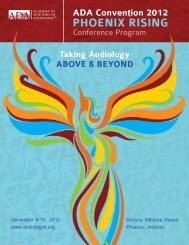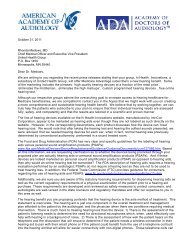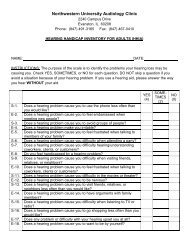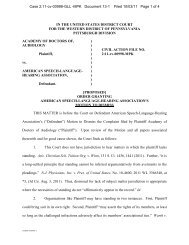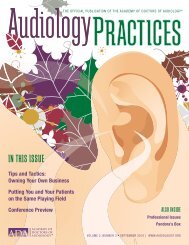IN THIS ISSUE - Academy of Dispensing Audiologists
IN THIS ISSUE - Academy of Dispensing Audiologists
IN THIS ISSUE - Academy of Dispensing Audiologists
Create successful ePaper yourself
Turn your PDF publications into a flip-book with our unique Google optimized e-Paper software.
hands-free conversation. Connectivity with a telephone also<br />
<strong>of</strong>fers the option <strong>of</strong> bilaterally streamed audio that can overcome<br />
some limitations related to ambient noise and poor signal-to-noise<br />
ratios (Picou & Ricketts, 2011). Wireless connectivity<br />
between a mobile phone and hearing aids also allows for<br />
the added safety <strong>of</strong> hands-free phone use while driving.<br />
Wireless features have introduced a new listening experience<br />
to many <strong>of</strong> our patients. To this point, below is a quote from<br />
a first-time user <strong>of</strong> hearing aids featuring wireless technology:<br />
“Last night was the first time I tried listening to the television<br />
wirelessly! It was like being in a movie! The commercials that<br />
I’ve been watching in the last couple weeks made more sense<br />
last night. I didn’t realize commercials had a valid reason<br />
to be on. It was just really nice to be able to enjoy the shows.<br />
I’m sure you guys have heard these things before but I just<br />
wanted to let you know it was awesome! I was a kid in a<br />
candy store!”<br />
The opportunity to hear the television directly through one’s<br />
hearing aids overcomes the disadvantages <strong>of</strong> distance, ambient<br />
noise, and low quality speakers that are <strong>of</strong>ten found in<br />
televisions. Wireless audio streaming from a telephone<br />
improves convenience with added safety and the opportunity<br />
to overcome challenges <strong>of</strong> ambient noise. Each <strong>of</strong> these<br />
features provides a benefit unique to hearing aids; the audio<br />
is frequency shaped to the patient’s hearing loss improving<br />
audibility <strong>of</strong> the streamed signal. These advancements allow<br />
patients to enjoy a wider variety <strong>of</strong> content and communication<br />
in more situations than were accessible without accustomed<br />
to without the benefits <strong>of</strong> wireless audio streaming. For<br />
many patients the ability to access streamed audio can be a<br />
large part <strong>of</strong> their daily routine, providing additional benefit<br />
and assisting them toward successful and routine use <strong>of</strong> their<br />
hearing aids. n<br />
References<br />
Galster, J.A., (2010). A new method for wireless connectivity in<br />
hearing aids The Hearing Journal. 63 (10), 36-39.<br />
Picou, E.M. & Ricketts, T.A. (2010) Comparison <strong>of</strong> wireless and<br />
acoustic hearing aid based telephone listening strategies. Ear and<br />
Hearing 31(6), 1-12.<br />
Jason Galster, Ph.D., is Manager <strong>of</strong> Clinical Comparative<br />
Research at Starkey Laboratories. He can be contacted at jason_<br />
galster@starkey.com<br />
Wireless Routing Technology:<br />
Clinical Tips and Tricks<br />
by Brian Taylor, AP Editor<br />
All major hearing aid manufacturers <strong>of</strong>fer products that utilize<br />
some type <strong>of</strong> wireless connection between consumer<br />
electronic devices, such as cell phones & televisions and<br />
the hearing instruments. Additionally, many manufacturers<br />
allow for wireless communication between two devices<br />
worn by the end user. Currently, there are three types <strong>of</strong> wireless<br />
transmission options, which were outlined in the previous<br />
article. Each manufacturer relies on one <strong>of</strong> these three<br />
options in their current wireless product portfolio. For each<br />
<strong>of</strong> these three wireless choices currently available to audiologists,<br />
there are advantages and limitations. When comparing<br />
these three wireless routing options, the prudent audiologist<br />
is encouraged to talk to the manufacturer representatives in<br />
order to gain a better understanding <strong>of</strong> the pros and cons <strong>of</strong><br />
each specific device. Variables such as transmission distance,<br />
ease <strong>of</strong> use for patients, potential to interfere with medical<br />
devices, “future pro<strong>of</strong>ing” and battery life are some <strong>of</strong> the<br />
important considerations that need to be discussed with each<br />
manufacturer’s representative.<br />
Given the potential <strong>of</strong> wireless routing to improve communication<br />
and overall patient satisfaction in many challenging<br />
listening situations, audiologists are advised to include wireless<br />
routing benefits as part <strong>of</strong> the pre-fitting dialogue with all<br />
patients. One tool that has potential to enhance this patientprovider<br />
dialogue is the TELEGRAM, developed by Linda<br />
Thibodeau, Ph.D, <strong>of</strong> the Callier Center at the University <strong>of</strong><br />
Texas at Dallas. The TELEGRAM is shown in Figure 1. Each<br />
<strong>of</strong> the letters <strong>of</strong> the TELEGRAM denotes a specific listening<br />
situation. Many <strong>of</strong> these listening situations have the potential<br />
to be improved (e.g. cell phones) when patients are able to<br />
utilize wireless devices. Furthermore, the TELEGRAM allows<br />
audiologists to evaluate communication in the unaided and<br />
aided condition on a 1 to 5 Lickert scale, thus, the TELE-<br />
GRAM can be used to measure real world benefit <strong>of</strong> the<br />
consumer device audiologists choose to wirelessly connect<br />
to the hearing instruments. In an age where measuring real<br />
world benefit <strong>of</strong> hearing aids is required; the TELEGRAM is<br />
an essential tool. <strong>Audiologists</strong> are encouraged to incorporate<br />
it into their pre-fitting communication assessment and postfitting<br />
follow-up protocol routines. n<br />
Reference<br />
Thibodeau, L. (2004). Maximizing Communication via Hearing<br />
Assistance Technology: Plotting beyond the Audiogram! Special<br />
Issue: Assistive Listening Devices. Hearing Journal, 57,46-51.<br />
AUDIOLOGY PRACTICES n VOL. 3, NO. 2 29



